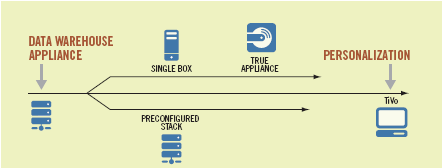LESSON - Keep It Simple: Gaining Efficiency Through Data Warehouse Appliances
By Foster D. Hinshaw, CEO, Dataupia
The data warehouse appliance was introduced specifically to address the needs of the “big data” vanguards. Just a few years ago, multiterabyte data warehouses were rare. Now, almost everywhere you look, organizations have to, want to, or plan to capture, retain, and eventually use vast amounts of data.
The appliance approach relieved IT of having to build its own infrastructure out of a mix of iron, wiring, and hand-coded software modules. If the infrastructure could be streamlined, more time could be spent on the data and information side of the equation—that is, the parts that brought tangible value to the business.
The data warehouse appliance achieved that by packaging together everything needed to build a data warehouse. Its goal was to deliver a “data warehouse in a box.” Data warehouse appliances are now far simpler to install and maintain than a typical database server plus storage infrastructure. They’re easier to get up and running, but is that enough? How hard is it to “personalize” them so that they can adjust easily to constantly changing requirements?
Personalizing Infrastructure
Why talk about personalization in the context of data warehousing? Why add personalization to the list of desired characteristics for a data warehouse appliance? I believe personalization is the element that brings the data warehouse appliance to the next level of usefulness—or relevance to the business drivers that are behind current data warehouse funding.
By personalization, I mean continually adjusting aspects of the appliance to suit an organization’s needs. The market will soon demand the ability to personalize infrastructure as customers start expecting their data warehouses to contribute to their agility instead of defining their limits. Greater flexibility will translate into more demands for scalability, accommodating both complex analytics and routine reporting with everything in between, handling more users wanting to do a greater variety of things with more data.

Figure 1: Data warehouse infrastructure architectures can be evaluated as to the degree and ease ofpersonalization, i.e., flexibility, they offer.
How Adaptive Is Your Infrastructure?
To profile your infrastructure’s flexibility, consider all the components that have to be touched when you make significant additions to users, data volume, or dependent applications:
- How many physical parts are involved? Include hardware, cables, power packs, etc.
- How many changes have to be made to the physical environment? Think green in terms of power, cooling, and space.
- How many changes to connected hardware are involved? Include all back-up, disaster recovery, and additional storage hardware.
- How many changes to dependent software—for example, the software used to support items covered in question 3?
- How much work is expected to get it to meet your basic operating requirements? Which skills, how much staff, and what dependencies on business users’ input are involved?
- How much work will it take to test? Consider IT hours and hours on the business side spent on testing.
Data warehouse infrastructure architectures can be evaluated as to the degree and ease of personalization, i.e., flexibility, they offer.
The higher the numbers in your answers, the more work, complexity, and risk are involved with every change. Traditional tiered storage architectures have very high numbers with their many moving parts and touch points.
The newest data warehouse appliances will have the lowest numbers because they are designed to be non-disruptive, requiring no adjustments to applications and no disturbance in the business user’s world. From the IT perspective, they quickly become good “data center citizens,” scaling easily, requiring little attention and few resources. They reduce the impact of change, making change feasible and personalization possible.
To build flexibility into your data warehouse, you need to start streamlining each of these change effects. The more minimal the impact of a change, the more easily you can adapt to the next wave of business requirements. Taking the steps you’ll need to bring your infrastructure forward to the point where personalizing is business as usual, is now an affordable option you can’t afford to ignore.